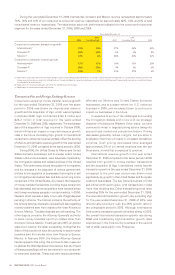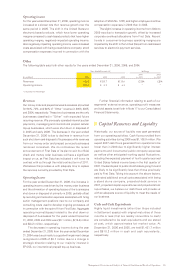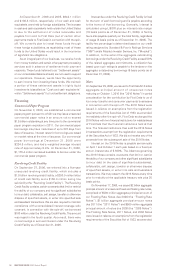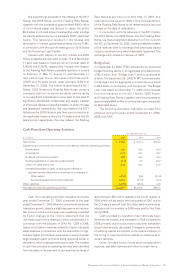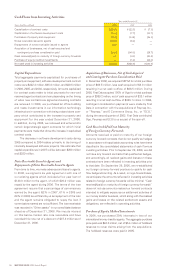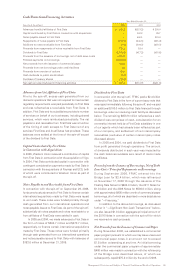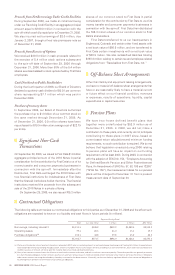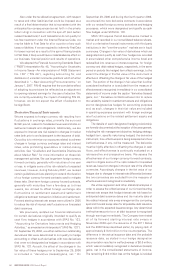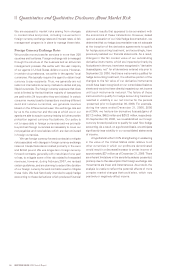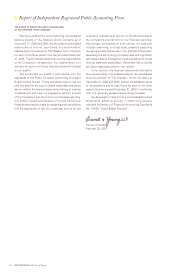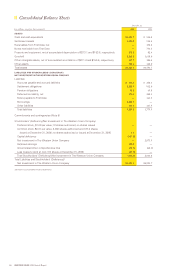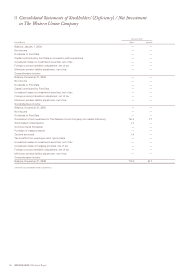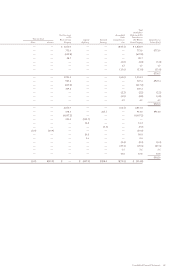Western Union 2006 Annual Report Download - page 59
Download and view the complete annual report
Please find page 59 of the 2006 Western Union annual report below. You can navigate through the pages in the report by either clicking on the pages listed below, or by using the keyword search tool below to find specific information within the annual report. Management’s Discussion and Analysis of Financial Condition and Results of Operations 57
|| Other Commercial Commitments
We had $55.9 million in outstanding letters of credit and
bank guarantees at December 31, 2006, with expiration
dates through 2011, certain of which contain a one-year
renewal option. The letters of credit and bank guarantees
are held primarily in connection with lease arrangements
and agent settlement agreements. We expect to renew
the letters of credit and bank guarantees prior to their
expiration in most circumstances.
|| Critical Accounting Policies
Management’s discussion and analysis of results of
operations and financial condition is based on our financial
statements that have been prepared in accordance with
accounting principles generally accepted in the United
States. The preparation of these financial statements
requires that management make estimates and
assumptions that affect the amounts reported for revenues,
expenses, assets, liabilities and other related disclosures.
Actual results may or may not differ from these estimates.
We believe that the understanding of certain key accounting
policies and estimates are essential in achieving more
insight into our operating results and financial condition.
These key accounting policies include stock-based
compensation, income taxes, derivative financial
instruments and capitalized costs.
Stock-Based Compensation
We adopted SFAS No. 123R effective January 1, 2006.
SFAS No. 123R requires all stock-based payments to
employees to be recognized in the income statement
based on their respective grant date fair values over the
corresponding service periods and also requires an estima-
tion of forfeitures when calculating compensation expense.
We selected the modified-prospective method of adoption
and straight-line amortization of compensation cost over
the requisite service period. We currently utilize the Black-
Scholes Merton option pricing model to measure the fair
value of stock options granted to employees and directors.
While SFAS No. 123R permits entities to continue to use
such a model, the standard also permits the use of a more
complex binomial, or “lattice” model. Based upon the type
and number of stock options expected to be issued in the
future, we have determined that we will continue to use
the Black-Scholes Merton model for option valuation.
Option-pricing models require us to estimate a number of
key valuation inputs including expected volatility, expected
dividend yield, expected term and risk-free interest rate.
The most subjective estimates are the expected volatility
of the underlying stock and the expected term when deter-
mining the fair market value of an option granted. Stock-based
compensation expense, including stock compensation expense
allocated by First Data prior to the spin-off on September 29,
2006 and the impact of adopting SFAS No. 123R, was $30.1
million for the year ended December 31, 2006.
Refer to Note 16 “Stock Compensation Plans” in
the notes to our consolidated financial statements for a
discussion of First Data’s and our stock-based compensation
plans and the adoption of SFAS No. 123R.
Income Taxes
Income taxes, as reported in our consolidated financial
statements, represent the net amount of income
taxes we expect to pay to various taxing jurisdictions in
connection with our operations. We provide for income
taxes based on amounts that we believe we will ultimately
owe. Inherent in the provision for income taxes are
estimates and judgments regarding the tax treatment of
certain items and the realization of certain offsets and
credits. In the event that the ultimate tax treatment of
items or the realizations of offsets or credits differ from
our estimates, we may be required to significantly change
the provision for income taxes recorded in our consolidated
financial statements.
We have established contingency reserves for material,
known tax exposures, including potential tax audit
adjustments with respect to our international operations,
which were restructured in 2003. Our reserves reflect
what we believe to be reasonable assumptions as to the
likely resolution of the issues involved if subject to judicial
review. While we believe that our reserves are adequate
to cover reasonably expected tax risks, there can be no
assurance that, in all instances, an issue raised by a tax
authority will be resolved at a financial cost that does not
exceed our related reserve. Any difference from our position
as recorded in our consolidated financial statements and
the final resolution of a tax issue will be reflected in our
income tax expense in the period during which the issue
is resolved. Such resolution could also affect our effective
tax rate for future periods.
To address certain tax aspects of the 2003 restructuring
of our international operations, discussions were initiated
with the Internal Revenue Service (“IRS”) pursuant to its
Advance Pricing Agreement (“APA”) program. However,
we were notified by the IRS in October 2006 that we will
not be able to conclude an arrangement acceptable to us
through the APA Program. Thus, the tax aspects of the
2003 restructuring will be addressed as part of ongoing
federal income tax audits.
We have benefited from the 2003 restructuring by
having our income from certain foreign-to-foreign money
transfer transactions taxed at relatively low foreign tax
rates rather than the U.S. and state combined statutory
tax rate. The amount of taxes attributable to such rate
differential is included in the “Foreign rate differential”
line in the effective rate reconciliation in Note 10
—
“Income Taxes” to our consolidated financial statements
and cumulatively totaled $210.8 million through
December 31, 2006.
Pursuant to a tax allocation agreement signed in
connection with our spin-off from First Data, we and First
Data each are liable for taxes imposed on our respective
businesses both prior to and after the spin-off. Although
we believe that we have appropriately apportioned such
taxes between First Data and us through 2006, subsequent
adjustments may occur as the tax filings for such years
are made with all applicable tax jurisdictions and such filings
are finalized.



